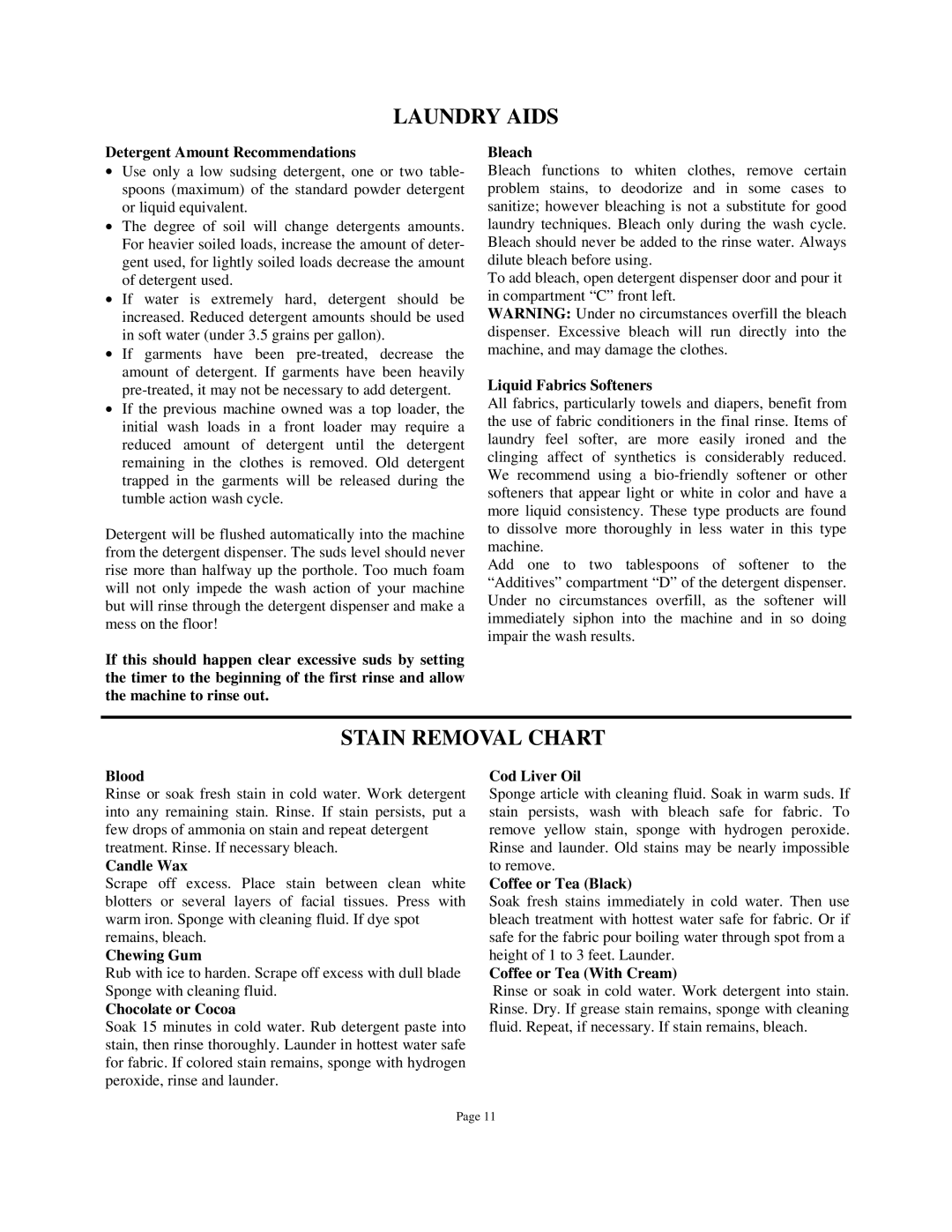LAUNDRY AIDS
Detergent Amount Recommendations
•Use only a low sudsing detergent, one or two table- spoons (maximum) of the standard powder detergent or liquid equivalent.
•The degree of soil will change detergents amounts. For heavier soiled loads, increase the amount of deter- gent used, for lightly soiled loads decrease the amount of detergent used.
•If water is extremely hard, detergent should be increased. Reduced detergent amounts should be used in soft water (under 3.5 grains per gallon).
•If garments have been
•If the previous machine owned was a top loader, the initial wash loads in a front loader may require a reduced amount of detergent until the detergent remaining in the clothes is removed. Old detergent trapped in the garments will be released during the tumble action wash cycle.
Detergent will be flushed automatically into the machine from the detergent dispenser. The suds level should never rise more than halfway up the porthole. Too much foam will not only impede the wash action of your machine but will rinse through the detergent dispenser and make a mess on the floor!
If this should happen clear excessive suds by setting the timer to the beginning of the first rinse and allow the machine to rinse out.
Bleach
Bleach functions to whiten clothes, remove certain problem stains, to deodorize and in some cases to sanitize; however bleaching is not a substitute for good laundry techniques. Bleach only during the wash cycle. Bleach should never be added to the rinse water. Always dilute bleach before using.
To add bleach, open detergent dispenser door and pour it in compartment “C” front left.
WARNING: Under no circumstances overfill the bleach dispenser. Excessive bleach will run directly into the machine, and may damage the clothes.
Liquid Fabrics Softeners
All fabrics, particularly towels and diapers, benefit from the use of fabric conditioners in the final rinse. Items of laundry feel softer, are more easily ironed and the clinging affect of synthetics is considerably reduced. We recommend using a
Add one to two tablespoons of softener to the “Additives” compartment “D” of the detergent dispenser. Under no circumstances overfill, as the softener will immediately siphon into the machine and in so doing impair the wash results.
STAIN REMOVAL CHART
Blood
Rinse or soak fresh stain in cold water. Work detergent into any remaining stain. Rinse. If stain persists, put a few drops of ammonia on stain and repeat detergent treatment. Rinse. If necessary bleach.
Candle Wax
Scrape off excess. Place stain between clean white blotters or several layers of facial tissues. Press with warm iron. Sponge with cleaning fluid. If dye spot remains, bleach.
Chewing Gum
Rub with ice to harden. Scrape off excess with dull blade Sponge with cleaning fluid.
Chocolate or Cocoa
Soak 15 minutes in cold water. Rub detergent paste into stain, then rinse thoroughly. Launder in hottest water safe for fabric. If colored stain remains, sponge with hydrogen peroxide, rinse and launder.
Cod Liver Oil
Sponge article with cleaning fluid. Soak in warm suds. If stain persists, wash with bleach safe for fabric. To remove yellow stain, sponge with hydrogen peroxide. Rinse and launder. Old stains may be nearly impossible to remove.
Coffee or Tea (Black)
Soak fresh stains immediately in cold water. Then use bleach treatment with hottest water safe for fabric. Or if safe for the fabric pour boiling water through spot from a height of 1 to 3 feet. Launder.
Coffee or Tea (With Cream)
Rinse or soak in cold water. Work detergent into stain. Rinse. Dry. If grease stain remains, sponge with cleaning fluid. Repeat, if necessary. If stain remains, bleach.
Page 11
